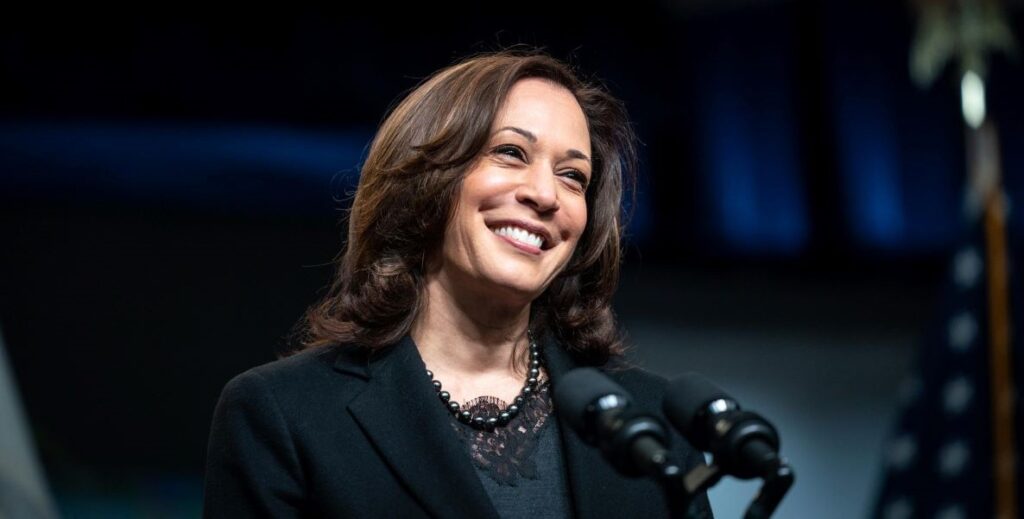Imagine, if you might, a sitting Democratic president, whose path to the Oval Office was paved after having served as vice president to a charismatic young president many years his junior, stubbornly rejecting calls to step aside in a reelection year after finding himself increasingly unpopular. Suddenly, he announces that he will, in fact, not campaign for another term. His own vice president, having not won a single primary, will take the nomination instead, and compete against a gruff, once-liberal, and previously defeated presidential candidate who likes to rail against the elites and finds himself doing surprisingly well with working-class voters.
This vice president, formally nominated at a contentious convention in Chicago, selects a former military reservist who spent time in Congress and as a governor, to run a campaign centered on “the politics of joy.”
The year, of course, was 1968, when President Lyndon Baines Johnson called off his bid for another term. His vice president, Hubert Humphrey, entered into an abbreviated campaign for president against Richard Nixon, who had come up just short in a presidential run in 1960. When Humphrey announced that he would seek the nomination, he pledged to run as a “believer in the American dream” and restore “the way politics ought to be in America, the politics of happiness, politics of purpose, politics of joy.”
One might say that he sought to run the campaign on vibes.
Today, Vice President Kamala Harris is off to a running start in her campaign against former president Donald Trump, earning such glowing headlines as, “Harris is pushing joy. Trump paints a darker picture. Will mismatched moods matter?”
The Harris campaign is betting that we are closer to 1980 than 1968, and that voters are ready, then as now, to turn the page on the politics of resentment and elect someone from California with a sunny disposition.
They did matter in 1968 — but not the way that Humphrey would have hoped. As historian Gary Wills puts it in his book Nixon Agonistes, “there was something in the atmosphere that made it seem faintly obscene for a presidential candidate … to use the phrase ‘politics of joy.’ The cities were in danger, and the college campuses, and the public schools.”
In the spring of 1968, hundreds of radicals occupied Columbia University to protest the Vietnam War. A similar scene played out this spring with protests on that campus and many others, challenging the country’s support for Israel against Hamas.
A few years before his presidential run, Hubert Humphrey said that, had he lived under such conditions as those in the ghettos, where riots were taking place, “I could lead a pretty good riot myself.” Such a provocative and ultimately damaging statement calls to mind Vice President Harris telling Stephen Colbert in 2020, regarding the George Floyd protests, “they’re not going to stop before Election Day in November, and they’re not going to stop after … and they should not.”
Of course, the 1968 parallels are not exact. Donald Trump is no Richard Nixon (even if both were counseled by Roy Cohn). Nixon’s campaign effectively centered around a return to law and order, with Nixon himself determined to run a race on content, not style, messaged through “simple, declarative sentences,” as he put it to Wills. The Trump campaign has yet to find an effective line of attack on Harris and Minnesota Gov. Tim Walz, and however one might describe Trump’s communication methods, it wouldn’t be concise.
Nixon would go on to lose Pennsylvania and Michigan in 1968. But he still won the presidency by a narrow 0.7 percent in the nationwide popular vote (just over 500,000 voters out of more than 72 million), a margin not reflected in the 301–191 electoral vote count.
Nixon’s administration was plagued by scandal, intrigue, and inflation. In popular memory, it was under Jimmy Carter’s singular term that inflation ran rampant, but there were significant increases in the rate in 1969 (6.2 percent) and 1970 (5.6 percent) in the Nixon years as well. It isn’t unreasonable to worry that Trump’s proposed program of tariffs, coupled with continued spending of the woefully mislabeled Inflation Reduction Act, persistent supply chain issues, and regulatory overhead from the Biden agenda, will result in further upward pressure on prices.
But historical parallels can only take us so far. Nixon wanted friendlier relations with China; Trump wants a second trade war with Beijing. Nixon expanded the Vietnam War into Cambodia; Trump has argued for a “peace through strength” approach to foreign policy that limits our interventions abroad. Ironically, despite being the law and order candidate, Nixon presided over a spate of political violence, when the nation saw, in just a two-year period in the early seventies, 2,500 politically motivated bombings. One can only pray that a second Trump administration doesn’t coincide with a return to such violence.
By 1980, Americans were done with malaise and ready for Ronald Reagan’s morning in America, presaged in pop culture by happy warriors like Rocky Balboa, Luke Skywalker and Christopher Reeves’s Superman, heroes who replaced the violent and cynical antiheroes of Taxi Driver, Death Wish and Dirty Harry.
The Harris campaign is betting that we are closer to 1980 than 1968, and that voters are ready, then as now, to turn the page on the politics of resentment and elect someone from California with a sunny disposition. The Trump campaign’s rejoinder is that, like 1968, the elites have let us down and the silent majority demands law and order.
For better or for worse, America will get a “politics of joy” not when such a thing is offered, but when voters demand it.
Kevin Sunday is a policy advisor with McNees Wallace & Nurick. He writes from Mechanicsburg, PA.
The Citizen welcomes guest commentary from community members who represent that it is their own work and their own opinion based on true facts that they know firsthand.

